 Louisiana outdoor writers, including this one, probably never thought they would be writing about this topic in our state: Black bears.
Louisiana outdoor writers, including this one, probably never thought they would be writing about this topic in our state: Black bears.
Oh, maybe we would recall the days of President Teddy Roosevelt’s famous hunt in Louisiana. Or maybe relay a story of bears crossing an open field on a federal refuge.
But here we are, talking bears. And here they are, too, becoming the center of a growing controversy over crowding other wildlife out of their habitat, property destruction and growing interactions with humans, including up-close encounters between bears and hunters and other safety concerns.
There are lots of opinions and self-proclaimed experts on the subject, maybe as many as there are bears. There is no accurate, official count of either.
Through 2019, population monitoring and estimates were focused on studies of only four bear subpopulations, Lower Atchafalaya Basin (LAB), Upper Atchafalaya Basin (UAB), Three Rivers Corridor (TRC) and Tensas River Basin (TRB)) that exist in the Mississippi alluvial valley (MAV), according to the Louisiana Department of Wildlife and Fisheries. Their most recent LDWF estimate for those four subpopulations is ~500-600 bears. The latest published U.S. Fish and Wildlife estimates are 500-750.
While they won’t go on the record as such, members of both organizations have said privately they believe the numbers are much higher. Although it’s being worked on now, the last official LDWF Louisiana Black Bear Management Plan is dated January, 2015.
Beginning in 2020, the LDWF began efforts to estimate bear numbers at a larger scale, or by Bear Management Area (BMA), and expanded study into seven BMAs. LDWF’s first efforts to estimate bears at this scale were completed in summers of 2020 and 2021 for BMAs 2, 3 and 4. As results of this work are finalized and analyzed, they expect to be able to determine best methods to more accurately estimate statewide numbers.
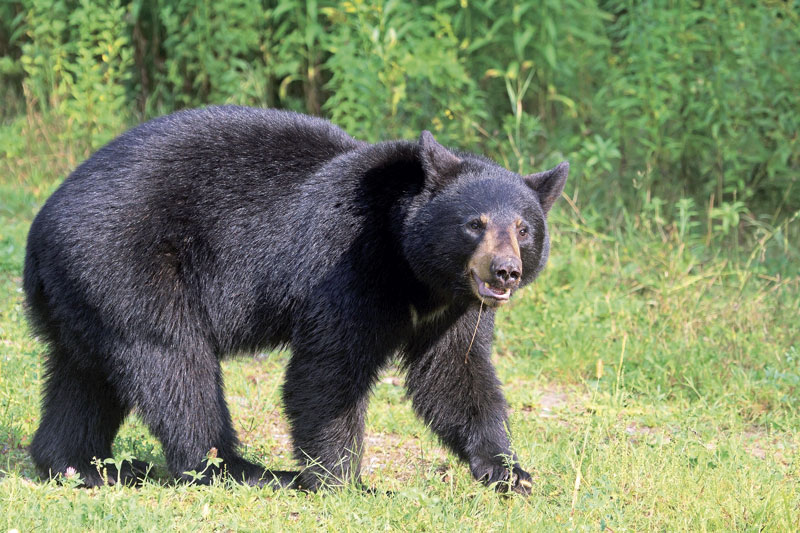
Concerns are growing
One thing cannot be denied. Growing populations of bears are becoming a public nuisance in some areas.
Bears have no natural predators in Louisiana and there is currently no hunting season. The issue has reached into the daily lives of thousands of Louisiana residents, farmers, property owners and hunters.
Pat Mabry managed and hunted his family land in Tensas Parish for decades. The family and their hunting club members are leaders when it comes to being good stewards of wildlife and the land. They appreciate Mother Nature’s bounty as much as anyone. Seeing a bear in the woods isn’t a problem. But seeing them by the dozens, seeing the growing damage they cause and seeing a decline in habitat for other wildlife, including lower numbers of whitetail deer, amplifies their concern.
A veteran outdoorsman, Mabry wouldn’t even go into the woods the last several years without carrying a pistol for personal protection in case of a close encounter that might go bad. He said he no longer felt comfortable letting his young grandchildren go in the woods alone. The reason? A serious and real concern over black bears. The bears have no fear of humans. They walk up to camps and go on the carports and porches. They follow hunters in the woods. And on occasion, they approach downed deer to try and claim them before hunters even get to them.
Mabry said he believed free-roaming bears are having a serious impact on deer populations and the habitat needed for other wildlife. It was his opinion that the unmanaged black bears pose a real threat to deer numbers in the state. He felt true concern about black bear interactions with humans and the destruction of property and equipment, threatening the ecological system that was already in place well before the re-introduction of lots more black bears.
Tragically, Mabry recently passed away suddenly this spring after speaking openly about the situation. But the concerns he had continue with a growing list of others.

Anxiety over safety
While there are no documented cases of bears attacking humans in Louisiana, there are numerous reports from other states where this has happened. Outdoorsmen fear it is just a matter of time. There are already reports of bears breaking into camps, cars and other structures in search of food.
This past season, deer hunter Dedria Brashear had a hair-raising experience when she attempted to recover a big 12-point buck she shot with her bow and arrow. She went back to camp for a while to give the buck time to expire. When she returned, her flashlight shined on the white belly of her deer. As she approached, she saw a large portion of one hindquarter had been eaten. She heard movement in the nearby thicket, shone her light in that direction and there was a big black bear. Alone in the dark with the bear, she could only wave her arms and shout repeatedly. She finally convinced the bear to leave, saying when it did, it sounded like a big bulldozer crashing through the woods in the dark.
There are many other similar stories. Stories of black bears climbing trees and deer stands with hunters in them. Stories of destructive acts in the woods, around camps and with deer stands and feeders.
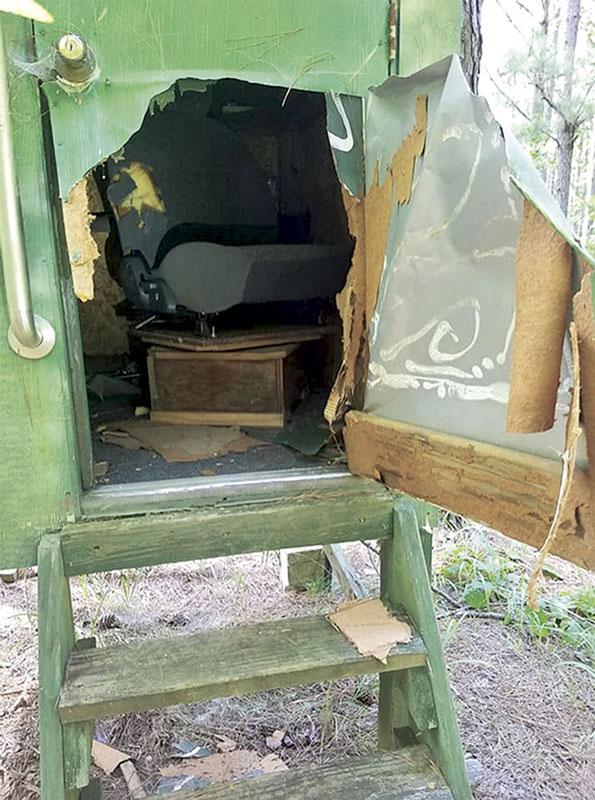
Farmers report heightening concern with annual losses to crops, especially corn fields. Bears will become comfortable in an area and set up shop inside a corn field where they are not visible except from the air. They’ll camp there, sit and eat up to two or three acres of corn in a 100 acre field and just bed down. This will be repeated in numerous fields, especially near wooded areas. Sugar cane farmers also face significant damage from bears looking for easy meals.
Beekeepers in areas with bears report losing their entire sets of hives. The list continues to grow, including bears congregating at rural trash dumpsters and occasionally roaming residential neighborhoods.
Interest of this issue is so high that a group of concerned outdoorsmen started a Louisiana Black Bear Report Facebook page late last year to get more accurate reports of black bear numbers, their locations and anxiety about contacts. The page quickly had more than 10,000 followers and to date, counts a half million views. Reports and photos of black bears have come in from across the state from people who actually witness the problem in real life.
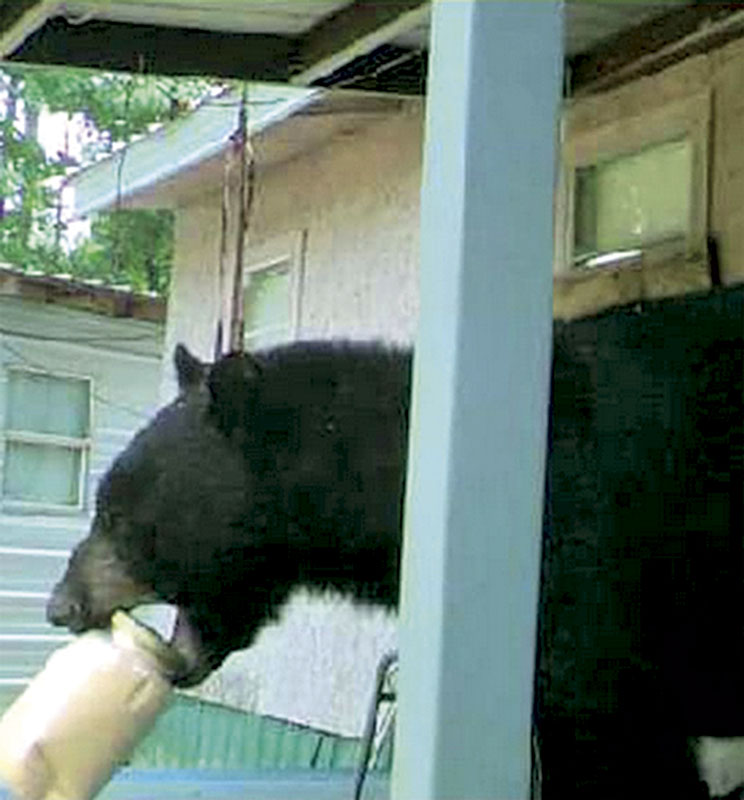
While LDWF reports the largest number of bears today roam the lower Atchafalaya, upper Atchafalaya and Tensas River areas, a large group of bears now inhabit Union, Morehouse and surrounding north central parishes. Authorities say these rapidly increasing number of bears are migrating down river systems from Arkansas and traveling to and some up from the Tensas corridor. Nobody knows how many are in this area.
Attempted progress to manage the situation has been met by opposition from protectionist groups that use the court systems to interfere with efforts of the LDWF or USFWS to properly manage bear populations. The main fear of those groups appears to be a legal bear season, which actual research has shown would be a viable tool.
The delisting
The USFWS first proposed to delist the Louisiana black bear in May 2015, after determining the recovery criteria, as defined in the 1995 Louisiana Black Bear Recovery Plan, had been met and threats to the bear were reduced or eliminated. In March of 2016, U.S. Secretary of the Interior Sally Jewell came to the state and announced that the Louisiana Black Bear would be delisted under provisions of the Endangered Species Act (ESA).
In 1992, there were as few as 150 bears existing in three known breeding subpopulations that were confined to the bottomland hardwood forests of Louisiana in the Tensas and Atchafalaya River basins.
Patience is wearing thin among groups that seek relief from this issue. Legislation to give the LDWF authority to properly manage bear numbers by holding a bear hunting season in some areas of the state was filed in the 2022 Louisiana Legislature. Senator Stewart Cathey led the effort.
“I have just heard from so many farmers, hunters, landowners and other citizens who have had countless issues with personal property damage and crop damage caused by the growing number of bears,” Sen. Cathey said. “The bears have become a real nuisance and have turned into a safety issue on both sides. It’s getting so a lot of fathers and grandfathers don’t feel safe taking their children and grandchildren in the woods because of encounters with bears. We already face enough challenges passing the legacy of hunting and enjoying the outdoors to our youth. Bears have no natural predators in Louisiana and they have little fear of human contact. They are growing in size and numbers. It’s not a healthy situation.”
Because of the changing nature of legislation, legal actions and updates in the law, interested parties will have to follow timely news reports for the latest information on the issue.
Most worrisome of all
Perhaps the most worrisome part of this story to hunters and conservationists like Greg Hicks is what growing numbers of unmanaged bears are doing in the already crowded woodland habitat of the state.
“The woods are already stressed to the max with hogs, whitetail deer and now bears, all competing for the same food sources and habitat. Add in turkeys and small game,” Hicks said. “Something’s going to lose, and I’m afraid it is going to be the whitetail deer. It is already impacting the number of people who hunt and the money they spend. The amount of money it is costing hunters because of the damage is extremely frustrating. That means it is costing the state tax dollars, too. That doesn’t even begin to tell what farmers are up against. We just don’t want the bear problem to get like the feral hog problem and be out of control before people in charge realize how significant it is and do something about it.”
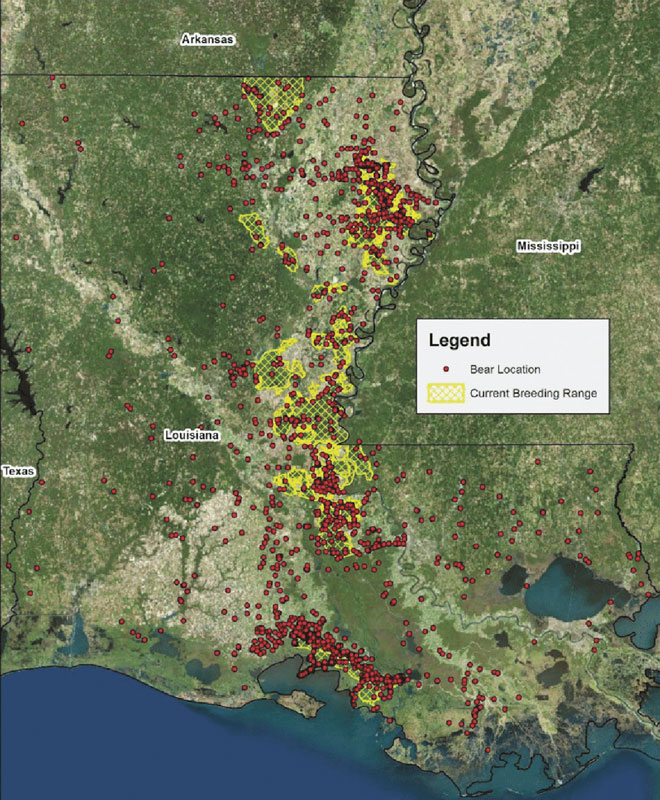
LDWF shares history, insight into black bears in Louisiana
The Louisiana Department of Wildlife and Fisheries and U.S. Fish and Wildlife Service and other groups have done extensive research on black bears in Louisiana. LDWF answered these questions from the Louisiana Sportsman to provide a better insight into that.
Question: Is there an accurate estimate available of the numbers of black bears believed to be in Louisiana today?
Answer: Through 2019, population monitoring and estimates were focused on studies of four subpopulations (Lower Atchafalaya Basin (LAB), Upper Atchafalaya Basin (UAB), Three Rivers Corridor (TRC), and Tensas River Basin (TRB) that exist in the Mississippi alluvial valley (MAV). The most recent estimate for the study areas we have monitored within those four subpopulations is ~500-600 bears. Beginning in 2020, we began efforts to estimate bear numbers at a larger scale or by Bear Management Area (BMA; Louisiana has 7 BMAs established in its Bear Management Plan. Our first efforts to estimate bears at this scale were completed in summers 2020 and 2021 for BMAs 2, 3 and 4. As results of this work are finalized and analyzed, we may be able to determine best methods to estimate statewide populations.
Question: How was that number derived?
Answer: Bear populations are estimated by Capture Mark Recapture (CMR) methods. This is done by deploying a number of hair snares for a given amount of time across the landscape that allow bears to be individually “captured and marked” by leaving a DNA signature. In a subsequent time period, the same process is repeated allowing “marked bears” to be “recaptured” and potentially more unmarked bears to be encountered. Mathematical formulas utilizing these numbers and ratios as well as telemetry data that model capture probability allow statistically valid estimates of populations.
Question: Is it growing or declining each year?
Answer: The population is stable to slightly increasing where adequate to good habitat exists. The most recent study area population growth data indicates stable to 1% growth.
Question: Do you feel the information collected through hours of research, agency coordination and expert study that led to the delisting of the black bear in Louisiana is still valid?
Answer: Yes.
Question: How does the LDWF work together with the USF&WS to work on management programs for black bears, count bears or establish programs around black bear work?
Answer: Bear population monitoring, conflict and management are primarily state responsibilities. The USFWS has been an important partner in de-listing black bears, and in providing cooperative PDM reports on the habitat components of the 5 year PDM period. They are also critical partners in managing some of the best and most important core area habitats at Tensas River, Bayou Cocodrie and Lake Ophelia National Wildlife Refuges (NWRs).
Question: The natural corridors that are normally part of bear discussions do not include the Union/Morehouse parish areas, but these areas seem to have more bears in them than some others. Where did the bears in those areas mentioned come from?
Answer: Union and Morehouse parishes are part of BMA 5. Bears in this BMA are likely coming from the Arkansas population as well as some from Tensas.
Question: What progress has been made to deal with black bear issues in the past 5-6 years since the state and federal wildlife authorities agreed it was proper to delist the black bear from the endangered species list?
Answer: Bear conflict is addressed by LDWF regional and programmatic efforts to educate the public encountering bears. BearWise (https://bearwise.org/) is a national effort in which LDWF has been heavily involved with to provide the public with information to avoid, or minimize conflicts with bears. The single most numerous cause of conflict with bears is providing them a source of food. This can be in the form of a deer feeder or an exposed garbage can/dumpster. Simply removing these food sources reduces or alleviates most sources of non-agricultural conflict. We will continue our efforts to educate the public in understanding and living with bears, where appropriate.
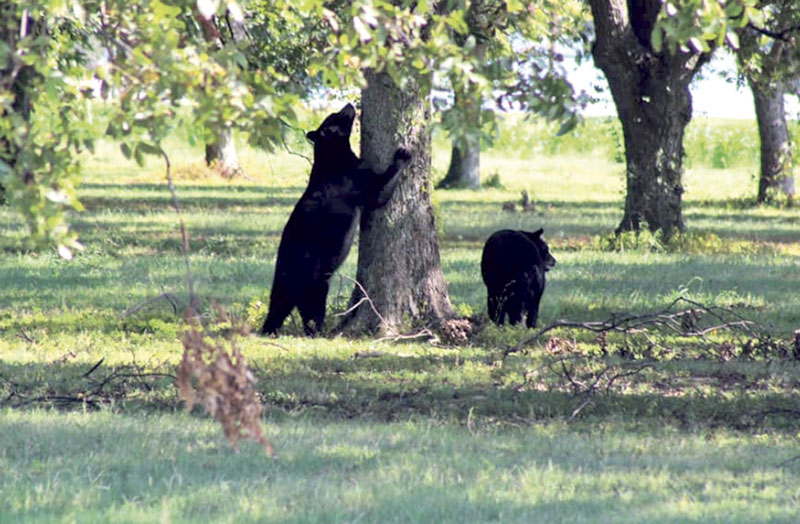 Question: Obviously wildlife like deer, ducks and turkeys have a huge economic impact on Louisiana with hunters spending millions of dollars and generating huge amounts of tax revenue. Does the black bear bring any type of actual revenue or economic value to the state like other wildlife?
Question: Obviously wildlife like deer, ducks and turkeys have a huge economic impact on Louisiana with hunters spending millions of dollars and generating huge amounts of tax revenue. Does the black bear bring any type of actual revenue or economic value to the state like other wildlife?
Answer: One of the greatest economic benefits of black bears to people in Louisiana has been the protection, restoration and conservation of bottomland hardwoods within the MAV. The occurrence or potential occurrence of black bears on lands within the MAV has provided higher conservation rankings among candidate tracts for enrollment in the Wetlands Reserve Program (WRP), and Conservation Reserve Program (CRP). Protecting and conserving critical black bear habitats has increased land values for recreational and conservation minded landowners. These same habitats provide incredibly important ecosystem values and services to all people, such as ground water recharge, flood control, water storage, water quality improvements, carbon sequestration, and habitat for migratory waterfowl, songbirds, furbearers, white-tailed deer, small game and many other wildlife species. Black bears are a large predator/omnivore that are a part of our natural history and they have important ecological functions, such as seed dispersal and scavenging. Seeing one in the wild can be a special occasion for many. Bears bring a level of wildness to our state that other species may not inspire.
Question: Thirty-five states have open black bear seasons. Why do you think, with Louisiana’s heritage of management of wildlife and hunting, is it an issue to have a season in Louisiana?
Answer: Black bears in Louisiana were only delisted 6 years ago. Additionally the USFWS has had legal action taken against it twice over the delisting decision. Working through this process with our conservation partners has required some patience. Additionally, Louisiana will never have the kind of robust population of bears compared to most states that have bear seasons, so we must be prudent in this consideration. LDWF management of the black bear will be focused on sustainability of the species within suitable habitat areas of the state.
Question: If the data supports a season to help manage populations of bears, using the same criteria and goals as for any other type of wildlife resource, will the LDWF support a season within proper management guidelines that can be set by the department?
Answer: Yes, LDWF does intend to establish hunting season rules and regulations for harvest of bears when and where we have adequate data to suggest it is appropriate and sustainable.
Question: Are there other means of managing black bear populations without a hunting season? Possibly relocations to other areas?
Answer: Teaching people how to live with bears is our first priority. LDWF moves bears when appropriate and there is a purpose to do so. However, the biological condition of bears must be weighed in these decisions, as it is often the driver on whether or not the animal will venture to return to the area from which it was removed.
Question: Is there anything else that you would like to share or add about bear population and management going forward in Louisiana?
Answer: Yes, LDWF strives to enrich and sustain all the natural wildlife and fisheries resources associated with the Sportsman’s Paradise. The black bear is another mega fauna species that we have been successful in restoring to the landscape, much due to the great collaboration of partners from USFWS, USDA/NRCS, NGOs and private landowners. Providing opportunities for harvest of bears in Louisiana will bring additional value to the animal, as well as these partners that have provided the resources for success of black bear restoration in Louisiana.


